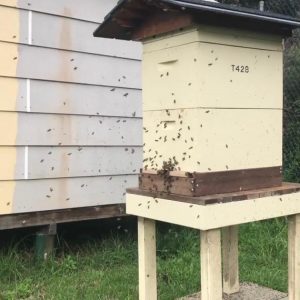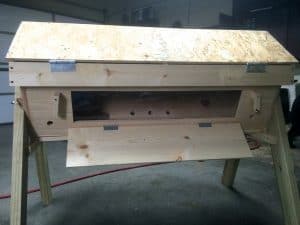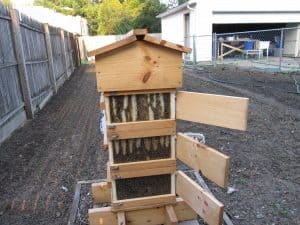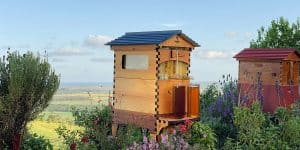Guide to bee hive types
Quick overview about the most common hive types
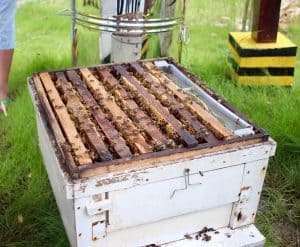
A bee hive
Are you a new beekeeper and looking into hive types before your purchase?
Are you an experienced beekeeper and need some refreshment?
Welcome!
First of all, do bees need a standardized hive?
Colonies of bees are a highly complex organized creature. This living being can perfectly take care of itself through the public spirit of the colony. It’s a super-organism!
Therefore, it is very surprising that it cannot build its own solid physical shell to protect itself from the elements. The bee colony needs a cave. At least the naturally living swarms of the Western honey bee, Apis Mellifera and the Eastern honey bee, Apis cerana. In a way, they are “cave breeders”.
If you now look at the caves populated by bees, you quickly notice that none of them is exactly like the other. Also the exposure of the caves can take different forms: Vertical, horizontal or diagonal. It’s the same on the inside. Also on the inside the caves differ from each other. In most cases, the surfaces facing inwards are irregularly polygonal. The building material consists of what the bees find.
Bees don’t need a standard hive
Therefore, bees don’t need a standard! At least with regard to type, form and material. As a result, also hive types can be very different from each other.
And otherwise the cave-breeding honeybee species would probably not have survived evolution. Precisely because there are no standardized caves in nature.
5000 years ago, Egyptians kept bees in so-called bee walls. Those were stacked tubes of Nile mud.
Later, people kept bees in hollow trees, log hives (Klotzbeute) and baskets woven from straw or willow rods6.
Today there are hundreds of different hive types, systems and variations worldwide7. Most of them respond to the following logic: “comfortable for the beekeeper, convenient for the bees”.
We humans create order and standards for ourselves, because they help US. We create hive types for our convenience. The bees adapt more or less well to them.
What you should consider
We introduce you some of the most common hive types. However, before the purchase, we recommend you to always consult an experienced beekeeper of your area. Ideally, a beekeeper who is committed to the well-being of the bees.
In addition, you should take into account the bee breed and the climate of your region.
Also, please consider which of the following paths you will take: Will you become a backyard beekeeper with one or two hives? Or will you and your family live off the money you make with the honey or other bee products?
In any case, always put the well-being of the bees in the foreground!
The ultimate goal of sustainable beekeeping is to live in harmony with bees. Humans should create an environment that supports the activities of the colony rather than exploiting them.
Bees4life promotes ‘natural beekeeping’. We like the idea of being rather ‘bee-carers’ than ‘bee-keepers’.
Still, it has to be practical. The type of hive you choose doesn’t make you to a better or worse bee-carer.
Therefore, we want you to point out two general guidelines before you decide on a specific hive type:
Two general guidelines before you purchase a hive
NUMBER ONE: You practice beekeeping for honey production. In this case you should be able to take out the honey combs without destroying the whole hive.
NUMBER TWO: You practice beekeeping for the bee’s sake or for pollination reasons or as backyard beekeeper. In this case you still have to be able to observe the condition of the bees. Make sure that you can check where the queen is located and see if the colony is doing well.
In the following, we present the most common of all bee hive types: the Langstroth hive
Langstroth hive
Golden Hive or One-Room Hive (Einraumbeute)
About 30 years ago, Thomas Radetzki designed the so-called Golden Hive. It is a hive for biodynamic beekeepers in temperate climates.
It is a one-room hive with deep, large frames that can accommodate brood, pollen and honey on the one comb.
Pros:
- 30 years of experience with this type of hive.
- The queen can move freely throughout the hive.
- A wax cloth covers the top of the frames. People can roll it to the side to only expose one frame at a time. Fewer bees are disturbed this way.
- No heavy boxes to lift as frames are harvested one at a time.
- Easily transportable.
- The hive doesn’t use any wire or foundation. Thin timber skewers built into the frames hold the comb stable when extracting.
- Easy frame inspection.
- Bees are free to build cell sizes as they require.
- Brood comb is constantly culled.
Cons:
- Equipment is necessary unless the beekeeper cuts and crushes the comb.
- The oblong shape can create cold spots in winter.
- Parts need to be precisely measured and cut to stop bees from filling gaps with either wax or propolis.
- Pests have lots of places to hide due to the frames.
Only suitable for backyard beekeepers with a few hives. Newcomers need an experienced mentor and the ambition to invest more time into their hobby.

